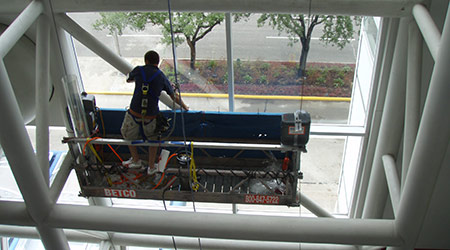On May 22, 2011 five people died and many were injured at St. John’s Hospital in Joplin, Mo., when a vicious tornado struck the town. Flying glass was the main cause of a number of the injuries at the hospital.
Here are four facts related to that incident and other potential ones:
• Flying glass shards from shattered windows are the No. 1 cause of serious injury when a building is struck by a powerful storm or bomb attack. Yet the majority of the country’s hospitals have little or no window protection.
• Hospitals can’t afford the potential repercussions of an unforeseen weather event or terrorist attack that could cause havoc and tragedy. Their role in their community is too vital.
• Hospital patients generally are immobile and thus significantly at risk should the building’s windows shatter
• Many hospitals have large amounts of exposed glass related to their design
Unfortunately, since the St. John’s Hospital tragedy few hospitals have acted to protect their windows against tornadoes, hurricanes or terrorist attack. Yet for years the federal government, commercial building owners, school districts, museums and galleries, convention centers and airports have been aggressively protecting their windows through the installation of security window film.
There’s another reason for film installation: Some security window films have the added benefit of conserving energy by controlling the amount of sun that enters the building.
The question is: When are hospitals and healthcare facilities going to follow suite?
Oklahoma City bombing and 9/11
The origin of protecting building windows with security films evolved out of the infamous Oklahoma City bombing. On April 15, 1995, a bomb planted by Timothy McVeigh in a rental truck detonated in front of the Alfred P. Murrah Federal Building in downtown Oklahoma City. The bomb blast killed 168 people and injured 680.
A number of those killed, and many of the injured, were the result of flying glass shards from the federal building and buildings located blocks away. As a result of this horrific incident, film companies began developing security films that, when properly installed, keep glass in place during catastrophic terrorist and weather events.
Over the next few years security window films were installed on a number of high-profile buildings, including the FBI headquarters and the Pentagon. The latter security measure proved fortunate when on Sept. 11, 2001, an American Airlines jet deliberately crashed into the Pentagon, killing 125 people and injuring scores of others. Amazingly, many lives were saved and injuries prevented because the of the security film installed on windows on the periphery of the crash location.
Within weeks of 9/11, the federal government moved to have security film installed on all the windows of the U.S. Capitol, House of Representative and Library of Congress buildings. Since then, many significant buildings in the Washington area and elsewhere have been protected by the installation of security films.
Why hospitals need protection
The idea of securing hospital windows is nothing new. In 2004, the Occupational Safety and Health Administration [OSHA] recommended that hospitals protect windows in all nursing stations, and in reception, triage and admitting areas. OSHA identified three factors that make hospitals an especially risky work environment:
• 24-hour access
• Increased use of hospitals to handle mental health patients who otherwise cannot find treatment
• Law enforcement use of hospitalization to contain aggressive and intoxicated individuals
Five years later, a survey by the International Association for Healthcare Security involving more than 200 hospitals found in-hospital crime rising across the board, with a total of 3,380 assaults in 2009 alone. This trend continued in 2012, with 98 percent of the healthcare facilities surveyed having experienced violence and criminal incidents.
Since then, there’s been a significant increase in high-profile terrorist attacks and mass shootings that have impacted nearly every segment of American society. Generally, the common thread on many of the attacks involves targeting places where large numbers of people are gathered. With that in mind, hospitals clearly could be an obvious target.
Additionally, foul weather events are on the increase, threatening hospitals located in areas frequented by hurricanes and tornados. The impact of a single storm on an unprotected hospital, as evidenced by the Joplin tragedy, can be devastating.
Two case histories
Some hospitals have moved to protect their buildings, patients and employees through security window film installation as well as conserving energy costs through sun control films.
In Jacksonville, Fla., UF Health Jacksonville, a University of Florida critical care medical center, had security film installed on nearly 300 windows. Funding for the project came from a Homeland Security grant awarded to the city. Because of its location in a hurricane belt, the film served the dual purpose of protecting the windows against potential terrorist attacks and bad storms.
Meanwhile, officials at Adventist HealthCare Shady Grove Medical Center had solar control film installed on all of its windows. Sun rays penetrating the glass were causing heat problems for patients and employees located near the windows. The heat gain from the sun also caused problems with the hospital’s HVAC system. The installation of the sun control film eliminated the problem and reduced the hospital’s energy bill, eventually offsetting the cost of the film.
Choosing the right film installation company
Once a hospital or health care facility decides to install window film to protect its glass or save energy, it’s critical the right company is chosen. Film installation on large buildings is a niche business with only a small group of qualified companies nationwide.
Aside from a fair price, facilities’ managers need to see proof of experience on other similar building projects. That often eliminates a number of candidates as very few companies have the necessary expertise of installing film on large buildings.
One often overlooked issue is the method of installation. Most security window film installations — which are almost always on the inside of the window — require a special attachment system to make sure the glass remains shatter resistant during an explosion or foul weather event. Here’s an example on how security film is properly installed using a wet glaze attachment system.
Another important consideration is the ability of the company to handle difficult projects. Hospitals in particular are unique environments that require flexibility on the part of the installation teams – hospitals operate 24/7 and are always busy. Also, hard-to-reach windows often call for special scaffolding and other equipment to ensure proper installation. Not every installation company can handle out-of-the norm projects.
As other markets continue to improve the security of their buildings, including installing security window films, hospitals and other health care facilities are likely to be taking a hard look at similar action. In a number of instances, decisions were made after unfortunate events. The question is, will hospitals be proactive or reactive in making the decision to protect their buildings, patients and employees?
George J. Tanber is marketing and website content manager for Commercial Window Shield. He can be reached at george@commercialwindowshield.com

 UF Health Hospitals Rely on Green Globes to Realize Their Full Potential
UF Health Hospitals Rely on Green Globes to Realize Their Full Potential How Healthcare Facilities Can Be Truly Disaster-Resilient
How Healthcare Facilities Can Be Truly Disaster-Resilient TriasMD Breaks Ground on DISC Surgery Center for San Fernando Valley
TriasMD Breaks Ground on DISC Surgery Center for San Fernando Valley Bigfork Valley Hospital Falls Victim to Data Breach
Bigfork Valley Hospital Falls Victim to Data Breach AI-Driven Facilities: Strategic Planning and Cost Management
AI-Driven Facilities: Strategic Planning and Cost Management